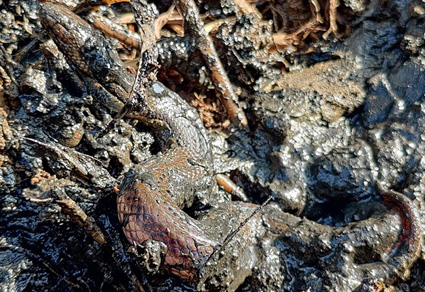Abstract
We present new findings on Dussumier’s Mud Snake Dieurostus dussumierii based on recent fieldwork conducted in and around Vembanad Lake (Kumarakom) in Kerala, Southwest India. We describe a series of 10 voucher specimens, eight females and two males, ranging from juveniles (207 mm) to adults (835 mm). We report new data on microhabitat associations, fossorial haunts, sympatric aquatic snakes (Fowlea cf. piscator, Cerberus rynchops), and intraspecific morphological variations in this species. We also illustrate and describe an overlooked, historical, non-type specimen of this species collected over a century ago. This work assembles the largest dataset of preserved voucher specimens used to characterize D. dussumierii, since its description 170 years ago.
References
- Adimallaiah, D. (2014) Report of Kerala Mud Snake Dieurostus dussumierii from a beach in Kochi, Kerala. Reptile Rap, 16, 39–40.
- Akhila, S., Sukanya, V.S., Anto, A. & Karunakaran, S. (2018) Prevalence of endoparasites in captive snakes of Kerala, India. Annals of Parasitology, 64 (2), 129–135.
- Berg, C. (1901) Herpetological notes. Comunicaciones del Museo Nacional de Buenos Aires, 1, 289–291.
- Bernstein, J.M., de Souza, H.F., Murphy, J.C., Voris, H.K., Brown, R.M., Myers, E.A., Harrington, S., Shanker, K. & Ruane, S. (2023) Phylogenomics of fresh and formalin specimens resolves the systematics of Old World Mud Snakes (Serpentes: Homalopsidae) and expands biogeographic inference. Bulletin of the Society of Systematic Biology, 2 (1), 1–24. https://doi.org/10.18061/bssb.v2i1.9393
- Boulenger, G.A. (1896) Catalogue of the Snakes in the British Museum (Natural History). Vol. III. Containing the Colubridae (Opisthoglyphae and Proteroglyphae), Amblycephalidae, and Viperidae. London (Taylor & Francis), London, xiv + 727 pp.
- Chandramouli, S. R. Baiju, M., Sebastien, J. & Ganesh, S.R. (2012) Expanded description of Enhydris dussumierii (Duméril, Bibron & Duméril, 1854) (Reptilia: Colubridae: Homalopsinae). Taprobanica, 4 (1), 42–47. https://doi.org/10.47605/tapro.v4i1.64
- Duméril, A.M.C., Bibron, G. & Duméril, A.H.A. (1854) n.k. In: Erpétologie générale ou histoire naturelle complète des reptiles. Tome Septième. Deuxième partie, comprenant l’histoire des serpents venimeux. Librairie Encyclopédique de Roret, Paris, pp. i–xii + 781–1536. https://doi.org/10.5962/bhl.title.112266
- Ferguson, H.S. (1895) List of snakes taken in Travancore from 1888 to 1895. Journal of the Bombay Natural History Society, 10 (1), 68–77.
- Ferguson, H.S. (1902) Travancore snakes. Journal of the Bombay Natural History Society, 14 (2), 386–387.
- Ganesh, S.R., Nandhini, T., Samuel, V., Sreeraj, C., Abhilash, K., Purvaja, R. & Ramesh, R. (2019) Marine snakes of Indian coasts: historical resume, systematic checklist, toxinology, status, and identification key. Journal of Threatened Taxa, 11 (1), 13132–13150. https://doi.org/10.11609/jott.3981.11.1.13132-13150
- Gyi, K.K. (1970) n.k. In: A revision of Colubrid snakes of subfamily Homalopsinae. University of Kansas Publication, Museum of Natural History. Vol. 20. No. 2. University of Kansas, Lawrence, Kansas, pp. 47–223.
- Hijmans, R.J., Cameron, S.E., Parra, J.L., Jones, P.G. & Jarvis, A. (2005) Very high resolution interpolated climate surfaces for global land areas. International Journal of Climatology, 25, 1965–1978. https://doi.org/10.1002/joc.1276
- ICZN [International Commission on Zoological Nomenclature] (1999) International Code of Zoological Nomenclature. 4th Edition. International Trust for Zoological Nomenclature, London, 306 pp.
- Jan, G. (1863) Elenco sistematico degli ofidi, descritti e disegnati per l’iconografia Générale. Lombardi, Milan, 143 pp. https://doi.org/10.5962/bhl.title.106683
- Joshi, J. & Karanth, K.P. (2012) Coalescent method in conjunction with niche modeling reveals cryptic diversity among centipedes in the Western Ghats of South India. PLoS ONE, 7 (8), e42225. https://doi.org/10.1371/journal.pone.0042225
- Kumar, A.B. & Captain, A. (2011) Recent records of the endemic Kerala mud snake, Enhydris dussumierii (Duméril, Bibron & Duméril, 1854) from India. Current Science 100 (6), 928–932.
- Kumar, A.B., Sanders, K.L. George, S. & Murphy, J.C. (2012) The status of Eurostus dussumierii and Hypsirhina chinensis (Reptilia, Squamata, Serpentes): with comments on the origin of salt tolerance in homalopsid snakes. Systematics and Biodiversity 10 (4), 479–489. https://doi.org/10.1080/14772000.2012.751940
- Mathew, L. (1965) The Development of Chondrocranium and Ear in the Snake Enhydris dussumieri Smith. Doctoral thesis submitted to the Sanathana Dharma College, Alappuzha, University of Kerala, 160 pp., 30 pls. [https://shodhganga.inflibnet.ac.in/handle/10603/143197]
- Murphy, J.C. & Voris, H.K. (2014) A Checklist and Key to the Homalopsid Snakes (Reptilia, Squamata, Serpentes), with the Description of New Genera. Fieldiana: Life And Earth Sciences, 8, 1–43. https://doi.org/10.3158/2158-5520-14.8.1
- Murphy, J.C. (2007) Homalopsid Snakes: Evolution in the Mud. Krieger Publishing, Malabar, Florida, 249 pp.
- Nair, P.K. & Babu, D.S. (2016) Spatial Shrinkage of Vembanad Lake, South West India during 1973–2015 using NDWI and MNDWI. International Journal of Science and Research, 5 (7), 319–7064.
- Parameswaran, K.N. (1954) On the viviparous habit of the fresh-water snake, Enhydris dussumieri (Smith). Current Science, 23 (1), 27–28.
- Parameswaran, K.N. (1963) The foetal membranes and placentation of Enhydris dussumieri (Smith). Proceedings of Indian Academy of Sciences, 56 (5), 302–327. https://doi.org/10.1007/BF03051936
- Phillips, S.J., Anderson, R.P. & Schapire, R.E. (2006) Maximum entropy modelling of species geographic distributions. Ecological Modelling, 190, 231–259. https://doi.org/10.1016/j.ecolmodel.2005.03.026
- Rajan, B., Varghese, V.M. & Pradeepkumar, A.P. (2011) Recreational Boat Carrying Capacity of Vembanad Lake Ecosystem, Kerala, South India. Environmental Research, Engineering and Management, 56 (2), 11–19. https://doi.org/10.5755/j01.erem.56.2.270
- Ramamirtham, C.P., Muthusamy, S. & Khambadkar, L.R. (1986) Estuarine oceanography of the Vembanad lake Part I: the region between Pallipuram (Vaikom) and Thevara (Cochin). Indian Journal of Fisheries, 33 (1), 85–94.
- Schnase, J.L., Carroll, M.L., Gill, R.L., Tamkin, G.S., Li, J., Strong, S.L., Maxwell, T.P., Aronne, M.E. & Spradlin, C.S. (2021) Toward a Monte Carlo approach to selecting climate variables in MaxEnt. PLoS ONE, 16 (3), e0237208. https://doi.org/10.1371/journal.pone.0237208
- Smith, M.A. (1943) The Fauna of British India, Ceylon and Burma, including the whole of the Indo-Chinese subregion. Reptilia and Amphibia. Vol. III. Serpentes. Taylor and Francis, London, xii + 583 pp.
- Wallach, V., Williams, K.L. & Boundy, J. (2014) Snakes of the World: A Catalogue of Living and Extinct Species. Taylor and Francis, CRC Press, Boca Raton, Florida, 1237 pp.
- Werner, F. (1913) Neue oder seltene Reptilien und Frösche des Naturhistorischen Museums in Hamburg. Reptilien der Ostafrika-Expedition der Hamburger Geographischen Gesellschaft 1911/12. Leiter: Dr. E. Obst. Reptilien und Amphibien von Formosa. Jahrbuch der Hamburgischen Wissenschaftlichen Anstalten, 30 (2. Beiheft), 1–39 + 40–45 + 45–51. [1912]


